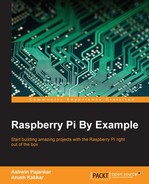In the previous chapter, we implemented a battery-operated portable Pi time-lapse box and a stop motion recording system. In this chapter, we will cover the basics of computer vision with Pi using the OpenCV library. OpenCV is a simple yet powerful tool for any computer vision enthusiast. One can learn about computer vision in an easy way by writing OpenCV programs in Python. Using a Raspberry Pi computer and Python for OpenCV programming is one of the best ways to start your journey in the world of computer vision. We will cover the following topics in detail in this chapter:
- Introducing computer vision
- Introducing OpenCV
- Setting up Pi for computer vision and NumPy
- Image basics in OpenCV
- Webcam video processing with OpenCV
- Arithmetic and logical operations on images
- Colorspace and the conversion of colorspace
- Object tracking based on colors
Computer vision is an area of computer science, mathematics, and electrical engineering. It includes ways to acquire, process, analyze, and understand images and videos from the real world in order to mimic human vision. Also, unlike human vision, computer vision can also be used to analyze and process depth and infrared images. Computer vision is also concerned with the theory of information extraction from images and videos. A computer vision system can accept different forms of data as an input, including—but not limited to—images, image sequences, and videos that can be streamed from multiple sources to further process and extract useful information from it for decision making. Artificial intelligence and computer vision share many topics, such as image processing, pattern recognition, and machine learning techniques.
